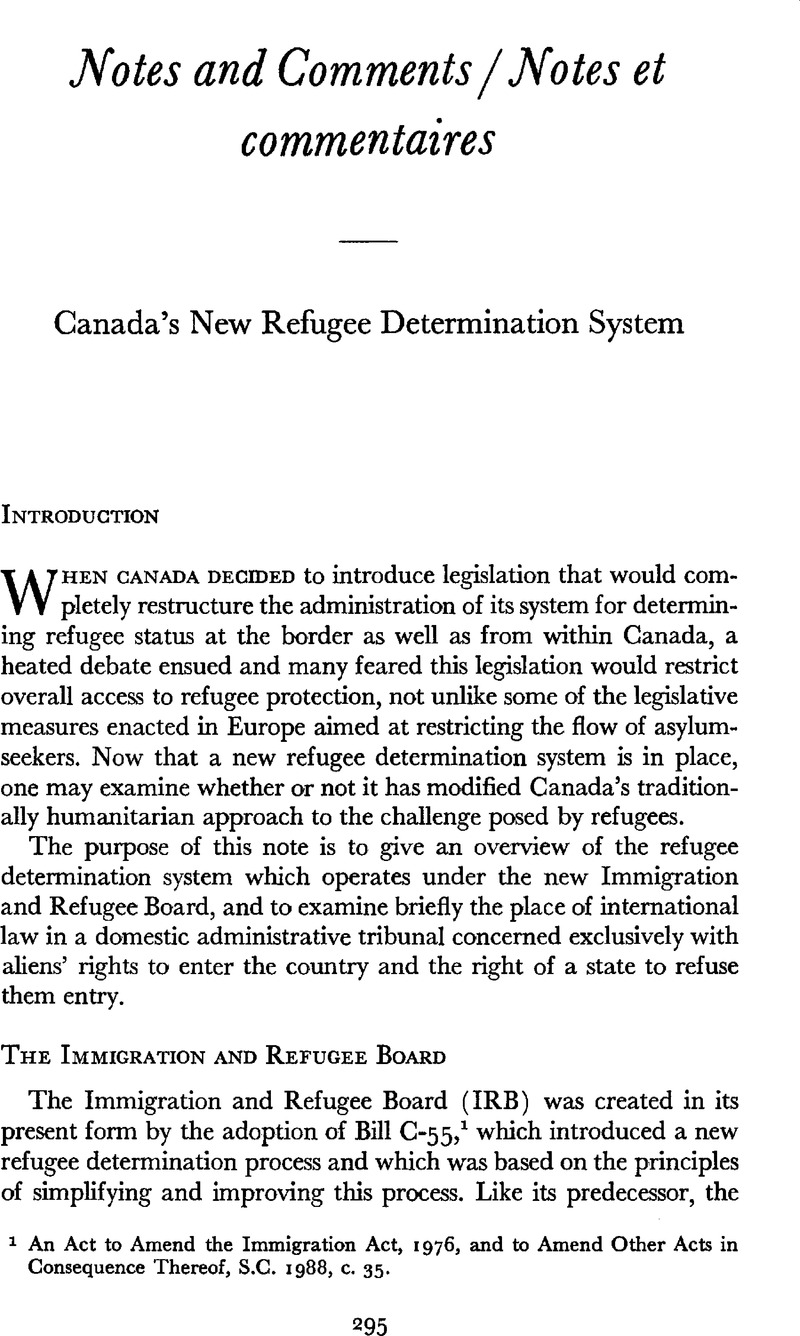No CrossRef data available.
Published online by Cambridge University Press: 09 March 2016

1 An Act to Amend the Immigration Act, 1976, and to Amend Other Acts in Consequence Thereof, S.G. 1988, c. 35.
2 R.S.C. 1985, c. 1-2. The statutory numbering of R.S.C. 1985, c. I-2 and S.C. 1988, c. 35 will be used as applicable. It should be noted that the proclamation of R.S.C. 1985 (4th Supp.) may affect the numbering used in this note.
3 Dirks, G. E., “A Policy within a Policy: The Identification and Admission of Refugees to Canada,” Canadian Journal of Political Science, 17:2, June 1984, 279, 301.CrossRefGoogle Scholar
4 Plaut, W. Gunther, Refugee Determination in Canada, Report to the Minister of Employment and Immigration (April 1985),Google Scholar which followed another study by Ratushny, E., A New Refugee Status Determination Process for Canada (May 1984).Google Scholar
5 A restriction that was held to be unfair and inoperative: Tonato v. M.E.I., [1985] ι F.C. 925 (F.C.T.D.).
6 Ss. 45 and 46 effectively give all aliens the right to put forward a refugee claim.
7 [19,85] i S.C.R. 177.
8 Ibid., 203.
9 Ibid., 211.
10 See, for instance, “Human Rights and the Protection of Refugees under International Law: Proceedings of a Conference Held in Montreal, November 29-December 2, 1987,” Canadian Human Rights Foundation, Institute for Research on Public Policy.
11 Ss. 48.oi(i)(b), 115 (1) (r).
12 Standing Senate Committee on Legal and Constitutional Affairs, Report on Bill C-55, 2nd Sess., 33rd Pari., 1986-87, at 5–7.
13 Supra, note 3.
14 I.R.B. News Release, Nov. 16, 1989.
15 S. 5 ( ι ) of the Act states that “No person, other than [a Canadian citizen or a permanent resident] has the right to come into or remain in Canada.” See also Gana v. M.M.I., [1970] S.C.R. 699.
16 supra, note 4.
17 Ibid., at 193 : “I believe … that a Convention refugee who does not have a safe haven elsewhere is entitled to rely on this country’s willingness to live up to the obligations it has undertaken as a signatory to the United Nations Convention Relating to the Status of Refugees.”
18 Ibid., at 189: “At common law, an alien has no right to enter or remain in Canada except by leave of the Crown.”
19 Sponsorship appeals, for instance, turn mostly on issues regarding the personal status of applicants (i.e., marriage, adoption, etc.).
20 M.M.I. v. Fuentes, [1979] 2 F.C. 331 (F.C.A.).
21 Re Vincent and M.E.I. (1983) 148 D.L.R. (3)(1385 (F.C.A.).
22 189 U.N.T.S. 137 (in force Apr. 22, 1954).
23 Boun-Leua v. M.E.I., [1981] 1 F.C. 259 (F.C.A.) ; another innovative aspect of the new legislation is the procedure open to persons finally determined to be Convention refugees to apply for landing.
24 S. 2(1) : “’Convention refugee' means any person who (a) by reason of a well-founded fear of persecution for reasons of race, religion, nationality, membership in a particular social group or political opinion,
(i) is outside the country of his nationality and is unable or, by reason of that fear, is unwilling to avail himself of the protection of that country,
or
(ii) not having a country of nationality, is outside the country of his for mer habitual residence and is unable or, by reason of that fear, is unwilling to return to that country, and
has not ceased to be a Convention refugee by virtue of subsection (2), but does not include any person to whom the Convention does not apply pursuant to section E or F of Article 1 thereof, which sections are set out in the schedule to this Act.”
25 Reproduced almost identically in s. 2 ( 2 ).
26 Reproduced textually in the schedule of the Act.
27 G.A. Res. 217, 3 UN GAOR. UN Doc. 1/777, (1948).
28 G.A. Res. 2200 (XXI)A, UN Doc. A/6316 (1966).
29 See Collection of International Instruments Concerning Refugees (Geneva: UNHCR 1979).
30 Goodwin-Gill, G., The Refugee in International Law 38 (Oxford 1983).Google Scholar
31 Ibid., at 39.
32 See Howland, T., “A Comparative Analysis of the Changing Definition of a Refugee,” (1987) 5 N.Y.L.S. J. Hum. Rights 33, at 53.Google Scholar
33 Cited in Grahl-Madsen, A., The Status of Refugees in International Law, Vol.1, 144 (Leyden: A. W. Sijthoff, 1966).Google Scholar
34 IRB news release, Nov. 16, 1989.
35 Immigration Appeal Board Annual Report for the year ending Dec. 31, 1988.
36 Compared to the 60 claimants (out of 781) who were granted status in 1988, after a redetermination. This figure, however, does not include those who were granted status by the Minister.
37 Morgan, E. M., “Aliens and Process Rights: The Open and Shut Case of Legal Sovereignty,” (1988) 7 Wisconsin Int'l L.J. 107–47.Google Scholar